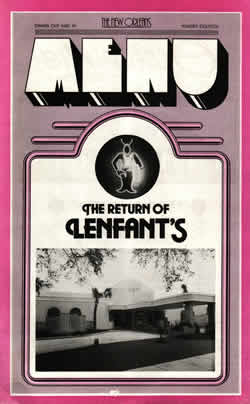
![]()
![]()
![]()
Lenfant's
Lakeview: 5236 Canal Boulevard
1940-1988
Lenfant's had three lives, each different from the others. Louis Lenfant and his family opened the restaurant just before World War II, and established it as what in New Orleans-speak would have been called a "modren" place. The place had a unique look, with curved corners not just inside, but outside, too. Neon tubes wrapped around the facade. Historian Ned Hemard calls the look "Streamline Moderne," noting the resemblance of Lenfant's to the rides at the Pontchartrain Beach amusement park, built around the same time.
 The restaurant's logo (displayed in neon, of course) was another distinctive icon. A lobster dressed in a tuxedo stood upright with a napkin over one claw. The fact that Lenfant's didn't often serve lobster never seemed to be questioned. Perhaps it was a crawfish. That would have made more sense, since Lenfant's was famous for its crawfish bisque.
The restaurant's logo (displayed in neon, of course) was another distinctive icon. A lobster dressed in a tuxedo stood upright with a napkin over one claw. The fact that Lenfant's didn't often serve lobster never seemed to be questioned. Perhaps it was a crawfish. That would have made more sense, since Lenfant's was famous for its crawfish bisque.
But of all the memories of Lenfant's, the one that lives on most pervasively was its parking lot. It was bigger than it needed to be. And it was adjacent to one of the many cemeteries in the neighborhood. No lights in a cemetery; no prying eyes. For many years, it was the place you went on a date to get a little dinner, and then to make out. Although the memory is fading now, for a very long time after Lenfant's stopped serving in its parking lot, a mention of the place would inevitably recall romantic interludes in that shell-covered expanse.
I wasn't old enough to have participated in that pleasure. My Baby Boom generation of Orleanians has a different association with Lenfant's. It was where you went to eat after a funeral. Or right before All Saints' Day, when your family went to the cemetery to dress up the tomb of loved ones.
Lenfant's menu was enormous and almost laughably cheap. A copy of a specials sheet I had until Katrina stole it list about twenty entrees, complete with salad or soup and vegetables, for less than a dollar fifty. Most of it was homestyle cookery, with a clear influence of the just-past Depression. Although a lot of this was good enough, it was clear that Lenfant's wasn't trying to serve the best food in town. Nobody ever accused the place of that.
After the war, Lenfant's became a very popular venue for private parties—everything from wedding receptions to Rotary Club meetings. It seemed to me that they were more involved with those than with a la carte business in the 1960s and 1970s.
Louis Lenfant retired in 1975, and sold Lenfant's to Joe Fein, Sr., the owner of the Court of Two Sisters. Fein—who was no more interested in multiple guidebook stars than Lenfant had been--modernized the menu but kept Lenfant's going as before, continuing the emphasis on catering.
That phase didn't last long. In the 1982 economic downturn, Fein closed the restaurant. It sat empty for a few years. Then it was Joe Marcello's turn. The former owner of the burned-down Elmwood Plantation saw Lenfant's as a prime spot for a revival. In 1984 he renovated the building thoroughly, keeping streamlined look while modernizing it quite a bit. What came out of the work was a striking restaurant.
He also had a memorable chef. Tom Cowman, who was looking for a gig after Jonathan closed. Chef Tom and Mr. Joe were not a logical team. They were sort of like Leonard Bernstein and Louis Prima--both great, but in very different ways. Joe knew what he wanted on the menu, and Chef Tom cooked it. But Joe questioned a lot of Chef Tom's flights of fancy.
One that the chef got away with was the serving of popovers at the table as soon as guests sat down. The popovers, looking like oversize muffins, eggy and hollow in the middle, were hot and buttery and wonderful.
The Marcello edition of Lenfant's was the all-time culinary peak for the restaurant. But it got caught in a tangle that would choke it to death. The city wanted to rebuild the busy intersection of Canal Street, Canal Boulevard, and City Park Avenue, for drainage and other issues. Lenfant's was inside the work area. Having all the access streets torn up was bad, but Joe Marcello just gritted his teeth and prepared to ride it out.
But one day during the digging a workman pulled up human bones. Not a big surprise; this part of town had been used as a cemetery for well over a century. But it brought work to a halt for months.
That was too much for Lenfant's, and in 1988 it shut down. After languishing for a few years, the great old streamlined building was torn down to make room for--ironically enough--a funeral home. The big parking lot came in handy for that, it with a very different mood from that of the old days.